The Sought-After Content Writer
For freelance content writers who want better work, better pay, and better clients.
Being broke sucks.
It especially sucks when you're working really hard and not getting anywhere. When you're cranking out thousands, maybe even tens of thousands of words every week and making barely any money.
"$15 per blog post."
"Our budget is around $225 per week for (4) 1500 - 2000 word articles."
That second listing works out to $56.25 for each post. 3.7 cents per word if you give them 1,500 words per post.
And that's more than the 2.8 cents some of the content mills would give you.
It's enough to make me cry.
When I look at freelance job board listings like that, it's no wonder so many freelance writers are happy about the idea of a $100 blog post.
But that's still a terrible pay rate.
Here's why:
If that $100 blog post takes four hours to write — an "average" amount of time according to Orbit Media's 2019 blogging study — that's $25 an hour. To start.
But your writing time is only part of the pay equation. There's also the time spent going back and forth with the client. There's sending the invoice, then maybe sending reminders about getting paid. There's filling out the W-9 IRS form and getting it back to them. And then maybe the client wants a few revisions.
Or maybe this is a one-time client, and it took you four hours of work just to land the gig in the first place.
If it takes you four hours to find the work, and four hours to write the post, that $100 took you eight hours to earn.
You earned $12.50 per hour.
Add in one hour of back and forth with the client, and you're at nine hours of work for your $100 blog post, or $11.11 per hour.
Now let's talk about taxes. Most financial advisors (and Dave Ramsay and TheBalance.com) recommend setting aside 25-30% of every freelance check you get to cover your taxes.
This brings your earnings down from $11.11 per hour to... $7.78 if you set aside 30% for taxes.
Give yourself a very modest budget of 53 cents per hour for your overhead (your computer, whatever services you pay to run your business) and you are down to $7.25 per hour.
Which is the Federal minimum wage.
"I'm a lean, mean writing machine," you say. "I can just plow through those blog posts."
Great. Because you're going to have to plow through those posts just to keep the rent paid and feed yourself.
Let's say you need to earn $4,000 every month to cover your expenses, including taxes.
Even if you earn $100 per blog post, that means you need to write 40 blog posts every month to pay your bills. 10 blog posts every week.
That's 1.7 blog posts every day, assuming you're indulgent and give yourself one day off a week. 1.4 blog posts every day if you don't get one day off per week.
Just don't ever have to stop.
Don't ever have a family emergency. Don't ever have to move, and make sure your computer never breaks. Never get sick — either sick from a cold or sick from writing until your hands ache.
Don't ever stop, you lean, mean writing machine.
Sounds pretty awful, right? And it is.
But it doesn't have to be like this.
$600 blog posts exist.
People pay $600 for blog posts all the time, every day.
There — somebody else, just now, paid a freelance writer $600 for a blog post. And it could have been you.
If you still don't believe me, here's proof. These are some recent invoices I've sent to my clients.
I have hundreds more. If you're the skeptical type, I could also show you the emails I've sent to clients outlining my rates, and the responses my clients have given accepting those rates. I can show you the bank deposits mirroring the invoice amounts.
This is not a scam. But I can see how, if you've been getting paid $15 to $50 per blog post, it might seem too good to be true.
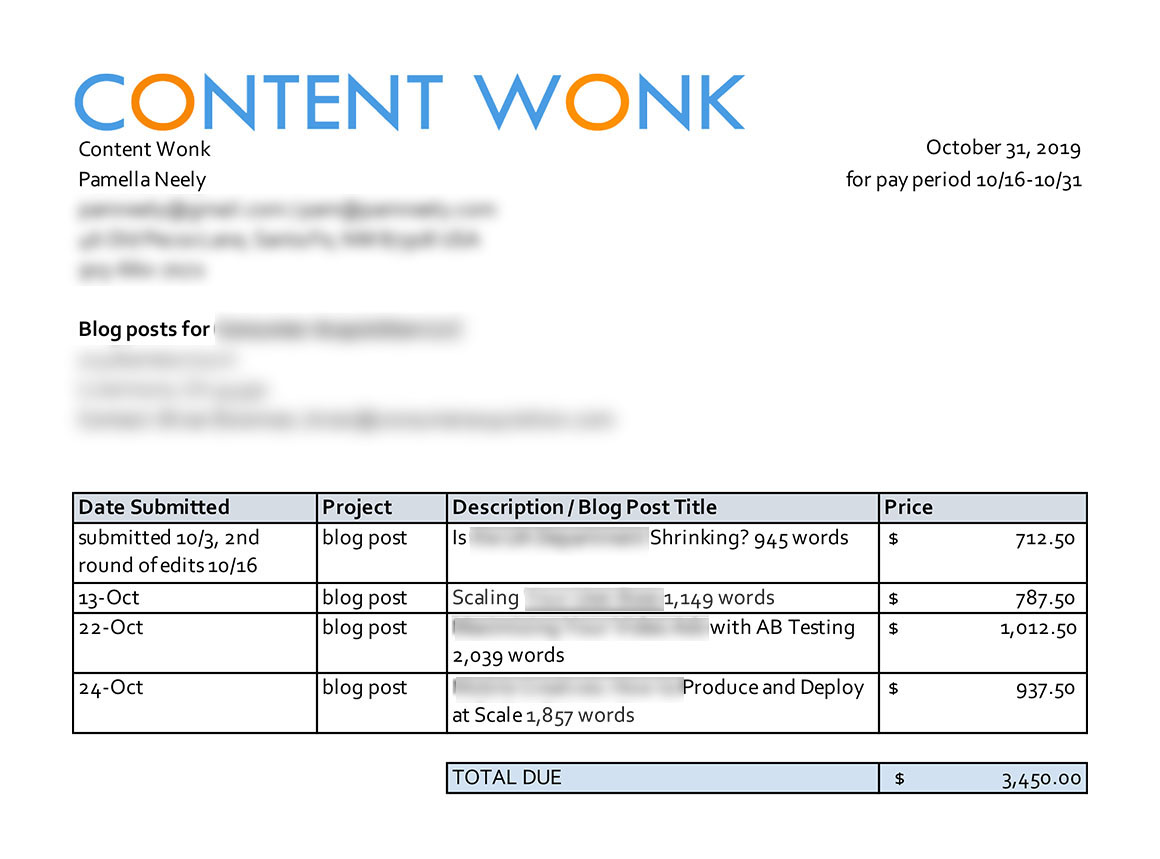
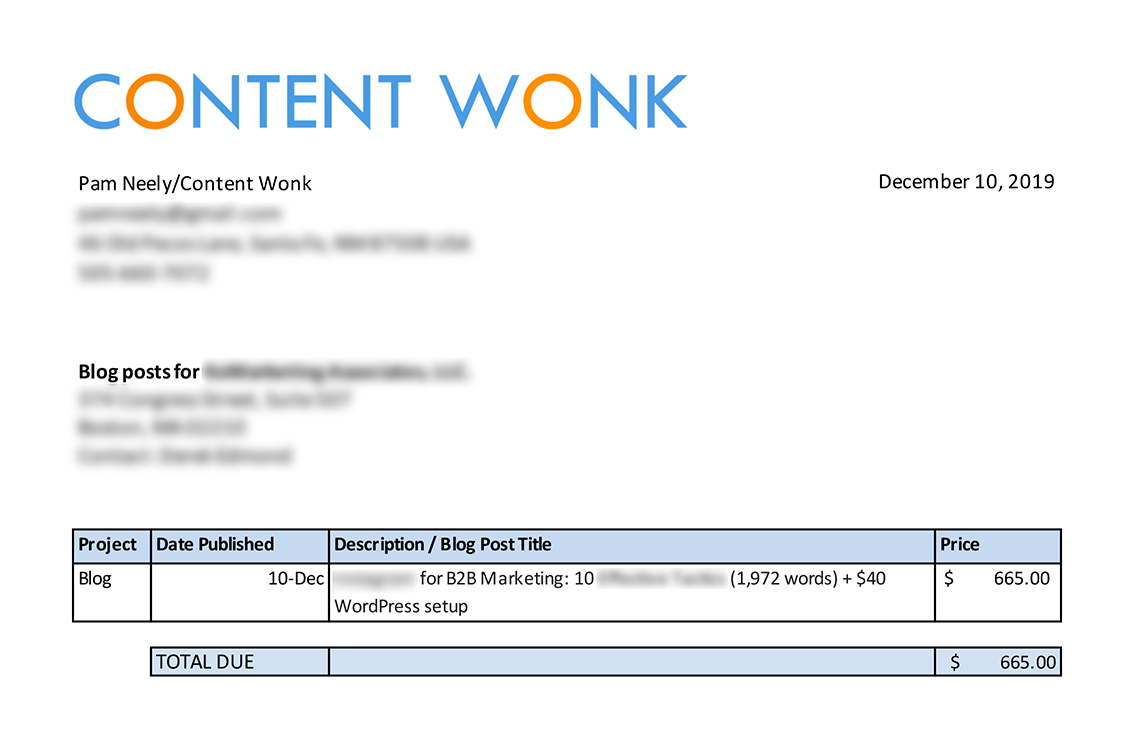

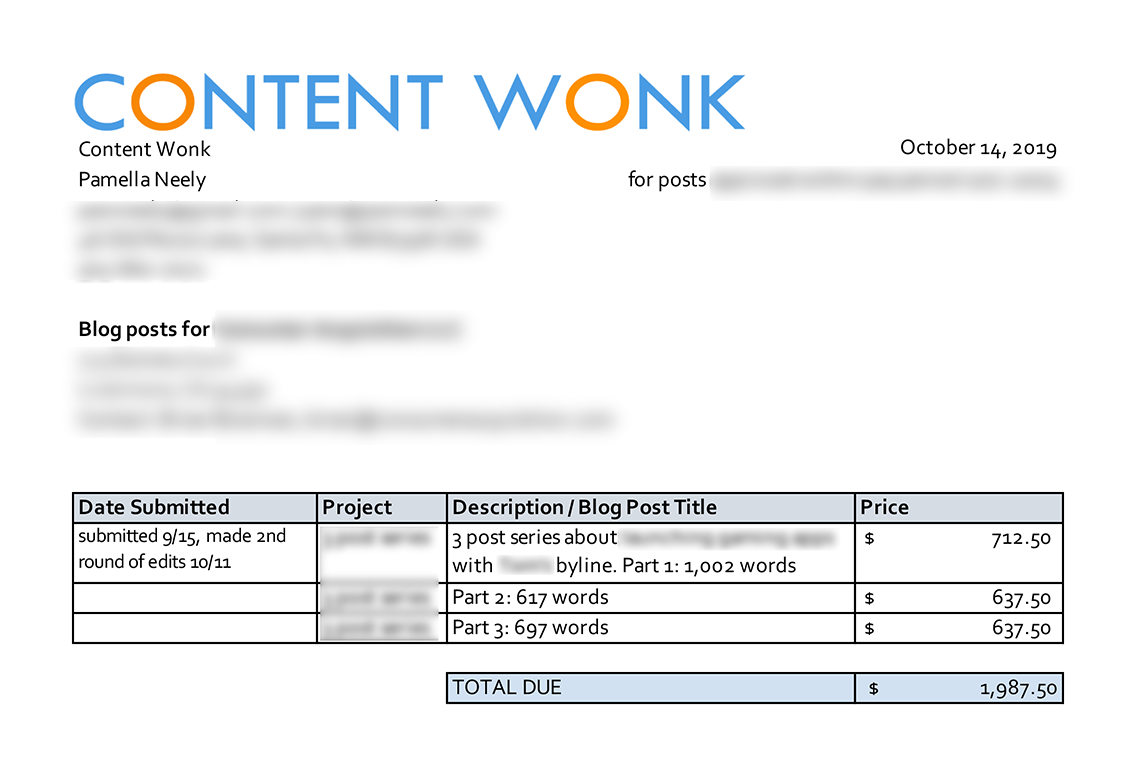
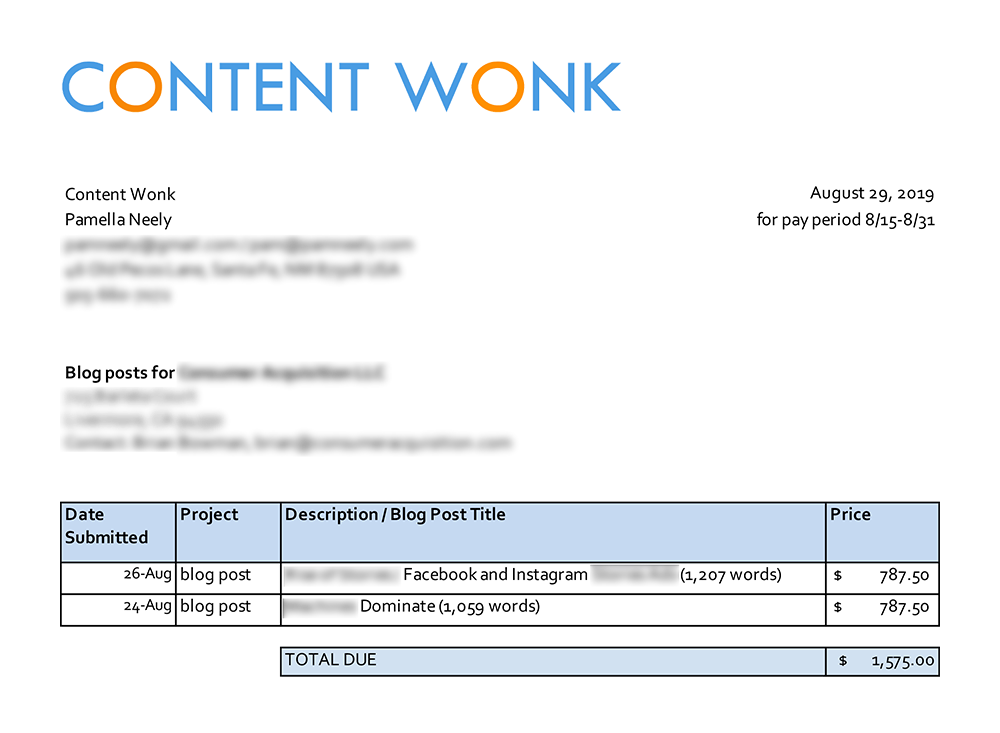
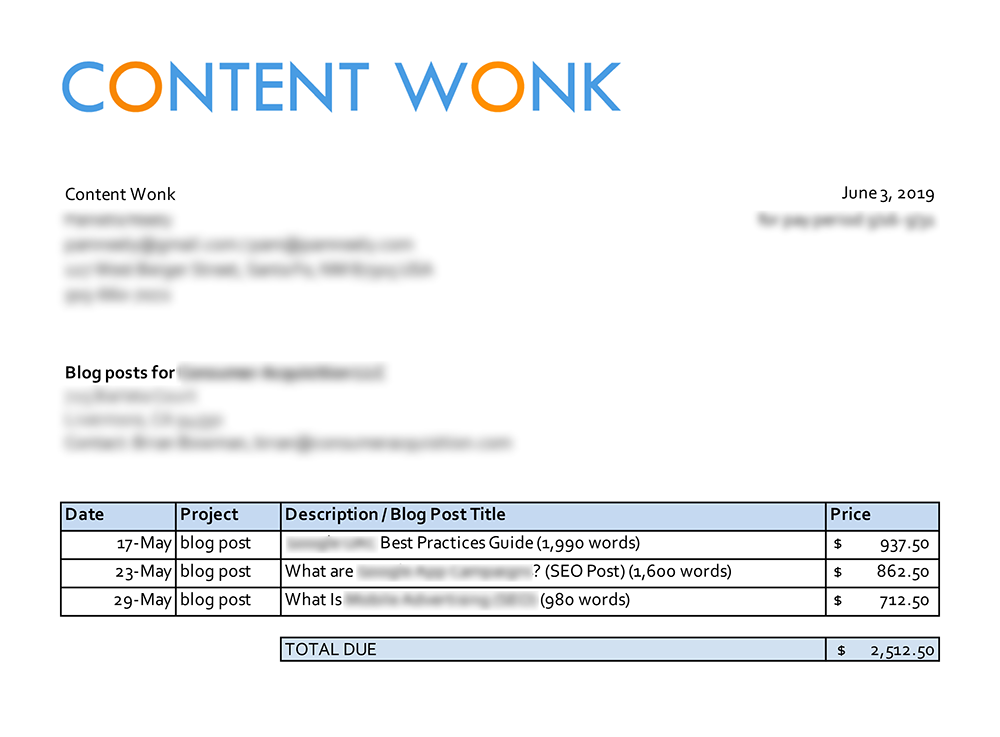
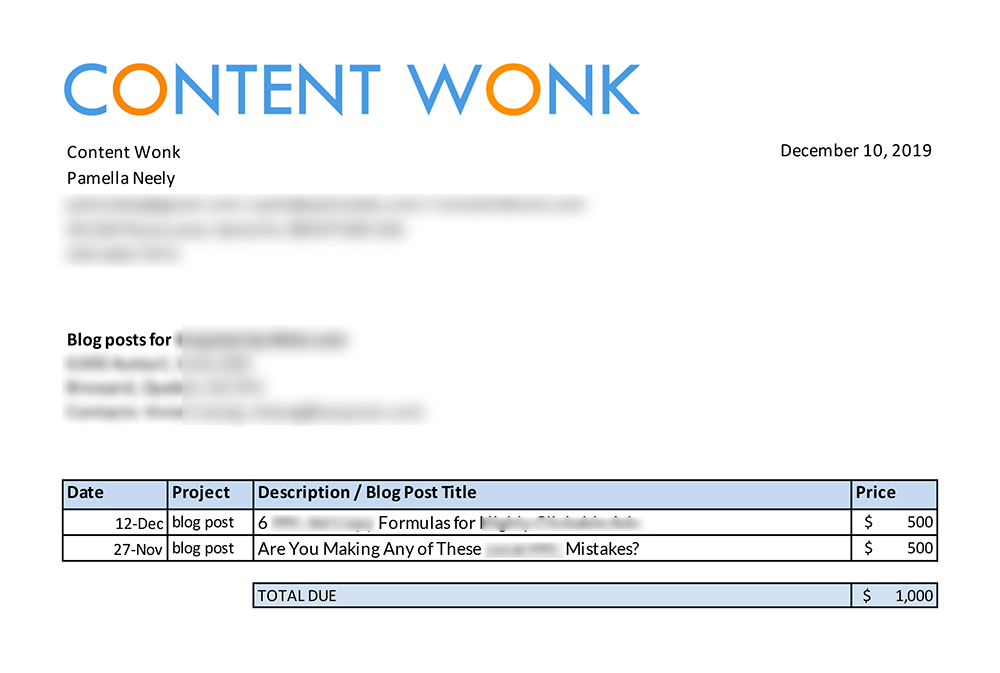
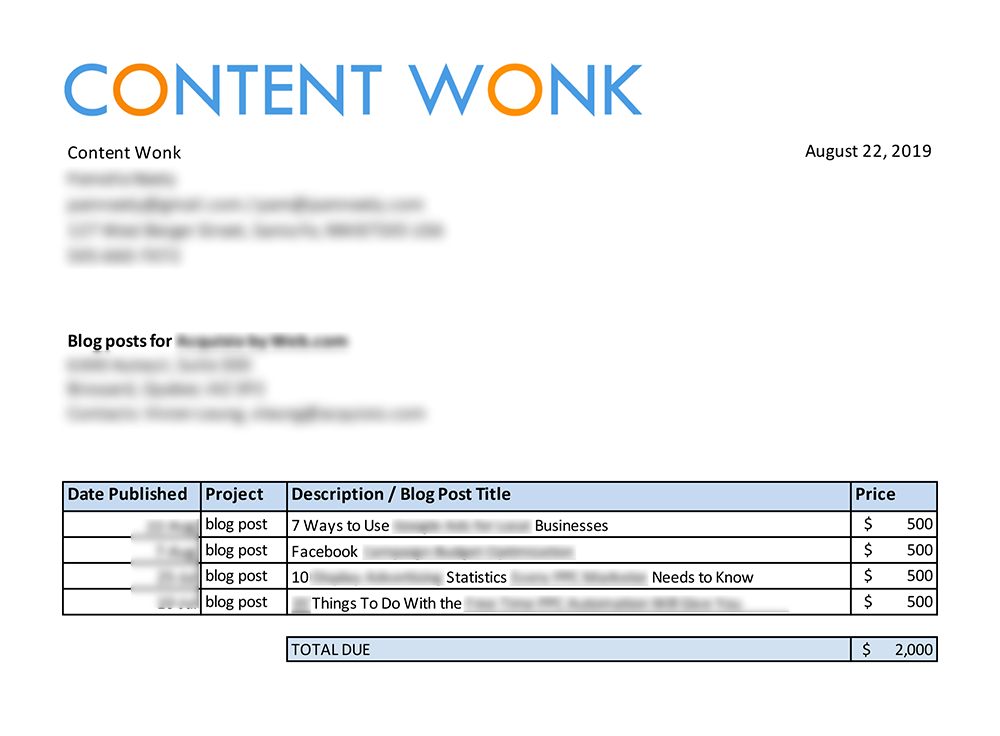
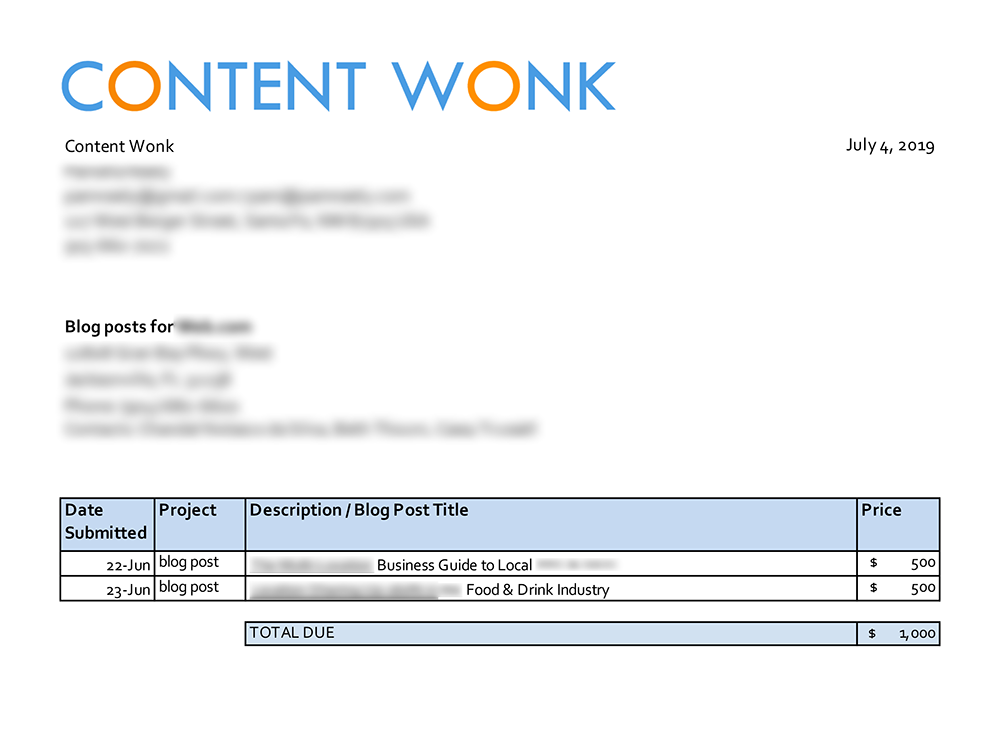
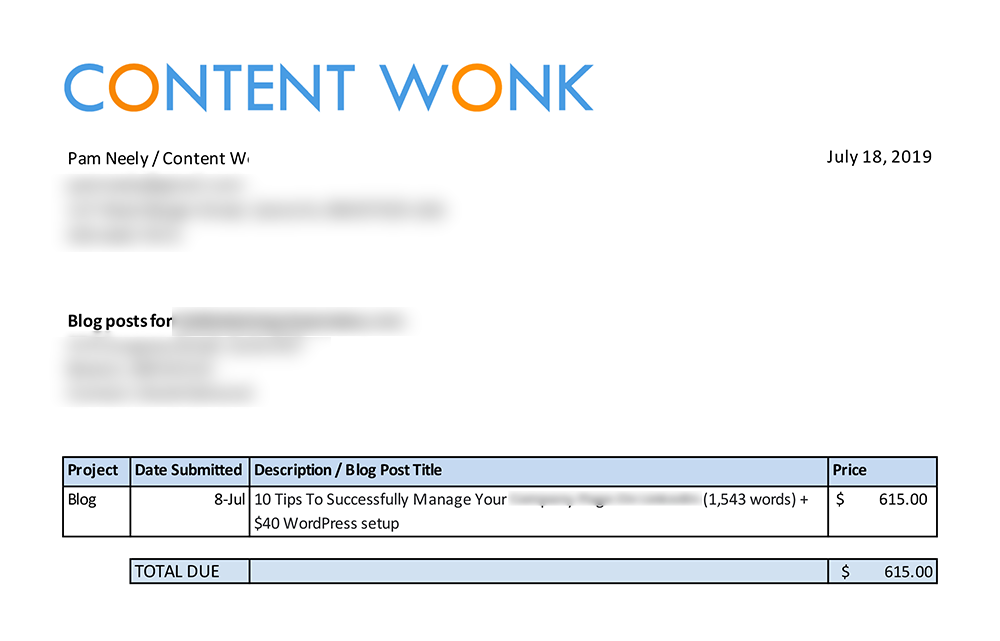
If you've been writing $15 to $50 blog posts, and you want to earn $600+ per blog post, you are going to have to change a few things.
1. You're going to have to start thinking less like an artist and more like a business person.
2. You're going to have to learn how to identify the type of clients who can pay you $600 per blog post.
Because yes: Some clients will just go dead silent when you quote them $500 per blog post.
These clients have no idea how to monetize content, and so they aren't really earning anything from the content they buy from you. So they can't afford to pay you any better.
And this is all fine. Because there are tens of thousands of other clients that can pay you $600+ per blog post.
These clients know how to make money with the content you write for them. You just have to learn how to find them.
3. You're going to have to pick a subject area that you can write about with authority.
You have to start thinking of yourself more as a subject expert and less like a struggling "I'll-write-anything-just-please-pay-me" freelance writer.
4. You'll have to approach these new clients and look like the type of freelance writer who charges $600+ per post.
In other words, you're going to have to look and act like a pro.
5. You'll have to deliver a blog post worth $600.
At this pay level, basics like avoiding spelling mistakes are table stakes. You'll need to do way better. But you can, and it's not that hard. Just basic stuff like including a meta description tag for the post will help. As will including a couple of interior links to relevant pages on the clients' website.
6. You're going to have to do just a little bit of content promotion (because most clients are terrible at promoting their content).
You do this because you want your content to be successful for your clients. So your blog posts have to get seen. Most blog posts, if you didn't know already, get four social media shares and no inbound links. Your content is has to do better.
7. You're going to have to manage your hours and your finances efficiently enough so that you keep your earnings high.
Those are the sorts of changes you'll need to make to earn $600+ per blog post, or at least $75 per hour. Only 10% of freelance writers earn $75 or more per hour, but you can be among them.
$600... even $1,000 blog posts exist.
Earning $600+ per blog post is much better financially (duh). But it's also much better for your self-respect.
It sucks to see your work undervalued. It sucks to be undervalued.
It hurts to hunch over a laptop, day after day, until your neck is stiff and your hands are sore from cranking out content.
So this is about more than you just writing $600 blog posts.
When you charge more, it also allows you to spend more time on what you write. So you end up writing better and delivering much higher-quality work.
Because you're a writer, and you're probably at least partially a perfectionist, it feels good to submit better work. Writers tend to put a lot of love and labor and pride into their writing (as we should), so it feels really good to turn in A+ work.
It feels good to write the kind of stuff you're proud to have your byline on. Pieces you can use for your portfolio... or to land more $600 blog posts.
So instead of just pumping out words at a breakneck pace, you could be working like you want to. You could be delivering copy and content with the depth and skill you know you're capable of.
Or you could just keep pumping out more $15, $50, maybe even $100 blog posts.
It's your call.
Welcome to The Sought After Content Writer course!
The Sought-After Content Writer course QUICK START GUIDE
For Brand-New Content Writers
Course Overview: What you need to know to earn a professional wage as a sought-after freelance writer
Why You Need to Charge $75 Per Hour (Or More) as a Freelance Writer
Why Some Freelance Writers Earn a Living - and Some Don't
A quick tour of the Thinkific course platform (just in case you're not familiar with it)
One page summary for Module 1
The big idea of this course - Part 1
The big idea of this course - Part 2
The big idea of this course - Part 3
The Big Idea of This Course - PDF Download
3-Question Quiz: The Big Idea of This Course
How to identify a business that can pay you $600 per blog post - Introduction
How to identify a business that can pay you $600 per blog post - Part 1 - Examples
How to identify a business that can pay you $600 per blog post - Part 2 - Examples
How to identify companies that can pay you well - PDF Download / ebook
3-Question Quiz: Do these companies have a content engine?
Exercise: Go find three companies you want to write for and see if they have a content engine or not.
Feedback for Module 1
Module Two One-Page Summary PDF
Introductory Video to Module 3
Niche Module Video 2 - The Math Behind Why Having a Niche is So Lucrative
Niche Module Video 3 - The Hourly Rate Penalty for Generalists
Niche Module Video 4 - What Marketers Want
Niche Module Video 5 - Examples of Writers with Well-Defined Niches
Niche Module Video 6 - Recap, the Big Picture, and How to Get Personalized Niche Help in the Course
A video for people who are resistant to picking a niche
Niche Inspiration: 112 Freelance Content Writing Niches (With Examples) (PDF ebook)
More Niche Inspiration: 107 Writers Organizations (PDF ebook)
How to pick a subject topic you'll be happy with for a long time
Exercise 1: List 20 subjects you know more about than the average person
Leave yourself room to pivot within your subject area
About specializing in content formats and "average client size"
Exercise 2: Distill your list of 20 subjects down to 1-3 items
Why You Only Need Five Clients (or "Don't Worry About "Limiting" Yourself to a Niche")
How to verify your market
Exercise 3: Go find at least 20 companies in each of the subject areas on your "short list" of subject list
How to become a subject expert: Content curation, networking, and more
Feedback for Module 2
Introduction to how to develop great blog post ideas
Personas and audiences
TOFU, MOFU, and BOFU and other vagaries of the buyer's journey
How to find and develop great blog post ideas
Exercise: Find a company you really want to write for and create 20 blog post ideas for it
Feedback for Module 3
Live blog post writing demo - Video 1 - Reviewing instructions from the client and writing headlines
Live blog post writing demo - Video 2 - Writing the opening of the post
Live blog post writing demo - Video 3 - Writing first 800 words or so
Live blog post writing demo - Video 4 - Full required length of blog post is written
Live blog post writing demo - Video 5 - Reorganizing what I had written
Live blog post writing demo - Video 6 - Doing a full and heavy rewrite
Live blog post writing demo - Video 7 - Rereading and rewriting the post again, then running it through Grammarly
Live blog post writing demo - Video 8 - Last edits, reading the post aloud, sending the post to the client
How to write a great headline
How to Write Emails
Feedback for Module 4
Creative Briefs
Introductory video
You need writing samples - also known as clips.
You need a website
How to develop a content plan (includes a template of a content plan)
You need a good LinkedIn profile
Sample LinkedIn review
You need to have a professional presence on social media
A few references or testimonials would be hugely helpful
A word about deadlines
A word about proofreading - and a secret trick to increase your hourly rate
Email etiquette
Feedback for Module 5
Introductory video for how to find clients
The "Want To Write For" List
Example of a "Client Hunt": Vegan Food Writer Niche
47 Ways Find Freelance Content Writing Clients
How to find clients through referrals
How to find clients through your personal network
How to get clients by getting quotes for your blog posts
How I Got $86,000 Worth of Work by Writing a Kindle Book
How to get clients through certifications and professional organizations
How to get clients through a column at a publication
Feedback for Module 6
Invoice Template To Use for Billing
A template for a client proposal.
Freelance Writing Packages
A quick recap of what we've covered in this course.
Before you go...
You have three days after purchase to request a refund.
Send me an email and I will refund your money.
Please do not worry about hassles with refunds. Part of the reason I use Thinkific's course platform is to have a third party involved in case there are any disputes.
Please see the testimonials for this course on the page about this course on my website.